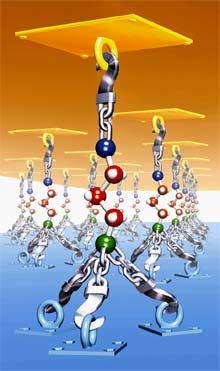Nanoglue for Electronics
Researchers at the Rensselaer Polytechnic Institute, in Troy, NY, have found that certain nanometer-long organic molecules can bond two surfaces that normally don’t stick together well. Surprisingly, the adhesive power increases when the nanoglue is exposed to very high temperatures.

The molecules could be used as an inexpensive, easy-to-apply glue in a variety of applications. For example, the nanometer-thick glue could be used to hold together tiny electronic components, as transistors and wires on computer chips continue to shrink, says Ganapathiraman Ramanath, a materials science and engineering professor who led the study, which was published in Nature last week.
The nanoglue, which belongs to a class of compounds called organosilanes, consists of a chain of carbon and hydrogen atoms with sulfur at one end and silicon at the other. The molecular chain normally disintegrates at temperatures above 300 to 400 ºC. But Ramanath and his colleagues have found that when they sandwich the molecules between copper and silicon dioxide, the molecules not only bind together the two materials, but the bond strengthens at higher temperatures. At room temperature, the resulting bond is three times stronger than a direct bond between copper and silica. At 700 ºC, the bond is 10 times stronger than normal.
One advantage of the glue is how little of it is needed. Similar gluing strengths can be achieved with very thick adhesive layers but not with such thin layers, Ramanath says. Since a single layer of the organosilane molecules arranged side by side holds the copper and silica, the thickness of the adhesive layer is the length of a single molecule: close to one nanometer. At 35 cents a gram, the new glue is affordable. And it should be easy to apply because the molecules tend to organize themselves in the proper orientation on the surface “like soldiers,” Ramanath says. “They all stand right next to each other and line up quite closely.”
Moreover, the researchers expect that they can tailor the nanoglue to adhere to different materials. By attaching appropriate chemical groups at the two ends of the molecular chain, researchers could engineer new types of organosilane molecules to glue together other dissimilar materials, such as insulators and semiconductors, or metal and semiconductors.
The organosilane’s increasing adhesive strength at higher temperatures is anomalous and “contrary to conventional wisdom,” says Om Nalamasu, a vice president and chief technology officer at Applied Materials, based in Santa Clara, CA, which supplies fabrication equipment to the semiconductor industry. “This might have neat applications and could open some new ideas and new concepts.”
One important application could be gluing copper wires that connect the various components on computer chips. Copper wires are deposited on insulating silicon-dioxide layers on a computer chip to keep the wires’ signals from mixing with each other. But copper doesn’t stick tightly to the silicon dioxide, and copper molecules diffuse into the silica. “There is a big need to isolate the interfaces chemically,” Ramanath says. “You don’t want them to mix, yet you want adhesion.”
Chip manufacturers currently use at least 10-nanometer-thick layers of materials such as tantalum or titanium between the copper and silicon dioxide. But as device sizes on high-performance computer chips plunge into the nanometer range, the new nanoglue, which is 10 times thinner, would be an ideal replacement. “With increasing miniaturization, you can’t afford to waste real estate on things that don’t do anything other than keep things together,” Ramanath says.
Keep Reading
Most Popular
Large language models can do jaw-dropping things. But nobody knows exactly why.
And that's a problem. Figuring it out is one of the biggest scientific puzzles of our time and a crucial step towards controlling more powerful future models.
The problem with plug-in hybrids? Their drivers.
Plug-in hybrids are often sold as a transition to EVs, but new data from Europe shows we’re still underestimating the emissions they produce.
Google DeepMind’s new generative model makes Super Mario–like games from scratch
Genie learns how to control games by watching hours and hours of video. It could help train next-gen robots too.
How scientists traced a mysterious covid case back to six toilets
When wastewater surveillance turns into a hunt for a single infected individual, the ethics get tricky.
Stay connected
Get the latest updates from
MIT Technology Review
Discover special offers, top stories, upcoming events, and more.